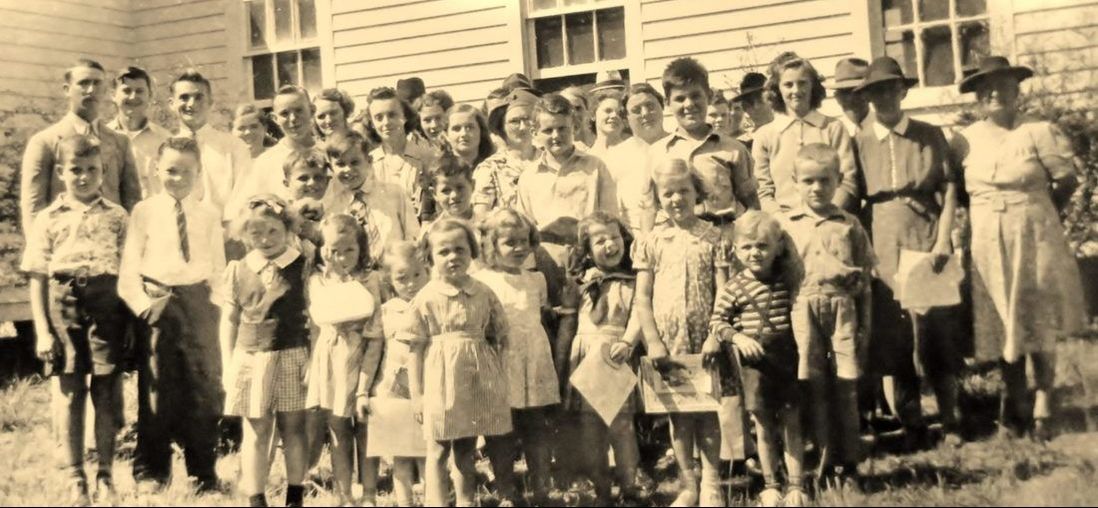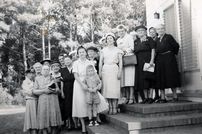Welcome to the Mt. Zion United Methodist Church History
|
Do all the good you can,
In all the ways you can, In all the places you can, At all the times you can, To all the people you can, As long as ever you can. ~John Wesley Founder of Methodism View a list of all Ministers serving the Currituck Charge since the days of Circuit RidersAfter the Ash Wednesday Fire March 3, 1976
The Rev. Denny Wise stands beside all that remained of the church structure (besides the old church bell and forged nails). An Easter Sunday Sunrise Service was held on the steps 40 days after the fire.
__________ To view a personal recollection of the Mt. Zion UMC Fire of 1976 click on "Download File" below:
*Unfortunately, in 2011 along with other items during a church break-in, the Communion set would be lost and never recovered.
|
Early Church History - Page 1 In 1976, the Rev. & Mrs. Denny Wise researched, wrote and published Mt. Zion United Methodist Church: 1772-1976 A History. Rev. Wise provides compelling evidence that in 1772, Rev. Joseph Pilmoor*, Methodist missionary from England, preached at the then called Mt. Zion Methodist Meeting House. The booklet provides a fascinating look back at the traveling conditions (usually by boat or through the swamps by horseback); the building specifications (hand-hewn heart of pine beams put together with wooden pegs and hand-forged nails); and the membership spanning many generations. [Click to visit REV. DENNY WISE's BOOK ONLINE!]
There are members of historical significance. Nathan Poyner had a distinguished career as Justice of the Peace, member of the House of Commons, a delegate to the first and second Provincial Congress at Newbern, and in 1775, served as Captain of the Revolutionary Militia of Currituck County. Captain Poyner was married to Ann Sanderson, whose father, Thomas Sanderson, Sr., probably owned the land where the original church stood. Later, Mrs. Thomas (Mary) Poyner, would give the church its first cleared title. On the easterly side of Mt. Zion was a port for sailing ships which sometimes brought visiting preachers. However, with the outbreak of the war, Francis Asbury, considered an unpopular Tory in 1775, never made a scheduled trip. He would later complete the trip in 1784 during more peaceful times. In 1795, the Reverend Edward Hardy of the Camden Circuit would court Colonel Thomas Jarvis' daughter, Lydia. After their wedding she later bore him seven sons. Rev. Hardy and his wife would become the great-grandparents of the famed General Douglas MacArthur. After Lydia died, the Reverend Hardy would eventually have three other wives, with the last being a Woodhouse. Rev. Hardy died in 1837. His grave is located in the Brumsey Road Cemetary. In 1889, one of Colonel Jarvis' grandsons, Thomas J. Jarvis, who described the church as "very dear" became the Governor of the state of North Carolina. According to Mr. Hill Mercer, whose father served as church sexton in the original building, there was once a circular stone pulpit that wrapped around the minister up to his neck. Folklore claimed it protected the preacher from any objects thrown by angry dissenters, but it was actually an Anglican custom of the time. The original building also had sliding wooden windows to open up for air, and presumably to close in case of Indian attacks! They probably served well in times of hurricanes. In this structure there was a balcony for slaves and according to the appointed circuit rider, Thomas Webb, 78 black and 79 white members attended church there in 1829. When the building was enlarged in 1880, the pulpit and balcony were dismantled and the wooden windows were replaced with glass. The oldest photo above left was taken in 1908. You may view larger images in the slideshow at the bottom of this page. Besides being called the Mt. Zion Meeting House, another early name for the church was Poplar Branch Methodist Church (due to location within the greater Poplar Branch township at the time.) Later when the 1st Grandy Post Office was established in a general store owned by Caleb Lee Grandy, the local patronage area around the post office would be named "Grandy." In addition Mt. Zion UMC in Grandy was also called the Methodist Episcopal Church in Society at Mt. Zion Meeting House. Click to view a 1917 newspaper article on a wedding in the church. Did you know that the word "United" was added to all Methodist Churches including Mt. Zion Methodist Church in 1968? You may read more about the history by clicking HERE. At one time Mt. Zion was part of a three church charge with Hebron and Sharon United Methodist Churches. Sharon United Methodist Church left the charge in 1978. Today, Mt. Zion United Methodist Church in Grandy remains part of the Currituck United Methodist Charge with her sister church, Hebron United Methodist Church located in Jarvisburg. In The Church Book of Mt. Zion Meeting House, minister records indicate church members (sometimes wealthy, prominent citizens) being expelled for misconduct such as "dancing, drinking, gambling, cursing, brawling, and other 'sins'." For this reason, those who wanted to join the church had to go through a six month probation period before being added to the church rolls. In 1842, the "Zion Tetotal Abstanance Society" joined the "Currituck County Tetotal Abstanance Society" with many citizens pledging not to drink or traffic in liquors. However, they were acceptable for medicinal or sacramental purposes! In the 1800s, an old style pump organ provided music in the church. Since the organist, Florence Jarvis, was quite short, a hired man had to come to church to pump the pedals while she played. In 1908, a contractor was hired to build the pulpit and altar railing. Unfortunately he used a local man, seven feet tall, for measurements on the altar rail and thus, not long after, the railing and altar had to be torn down and rebuilt. In 1920, the Ladies Aid Society purchased a piano for Mt. Zion. There were mixed emotions about this "new fangled instrument" since some members believed it was not appropriate for a church. In 1937 electricity arrived to replace kerosene lanterns. In 1945, white shingles and a steeple were added plus a vestibule and brick steps. The steeple housed a large bell originally from the old Mager Woodhouse plantation. The inside of the building was changed from two aisles to a center aisle arrangement. In 1963, classrooms were added for the amount of $5,000 creating two wings behind the church. Later an addition was built on the west side of the church which included kitchen and restroom facilities. In 1968, red carpeting was installed with red velvet kneeling pads. In addition, a Wurlitzer organ was purchased. In the fall of 1975, Mt. Zion UMC deemed a lot to the Currituck Charge for a parsonage next to the church, erected by the end of the year. Tragically, the evening of Ash Wednesday, March 3, 1976, the Mt. Zion United Methodist Church structure burned to the ground. After investigation by the Lower Currituck Volunteer Fire Department, the cause of the fire remained unknown. The only items salvageable were hand forged nails, some red bricks in the steps, and the old church bell. By clicking on "Download File" in the left column, you may read a personal recollection of the fire. Go to History page 2 Go to History page 3 SLIDESHOW OF OLD CHURCH PHOTOS BELOW You may click on the slides to pause or to view separately. | ||









